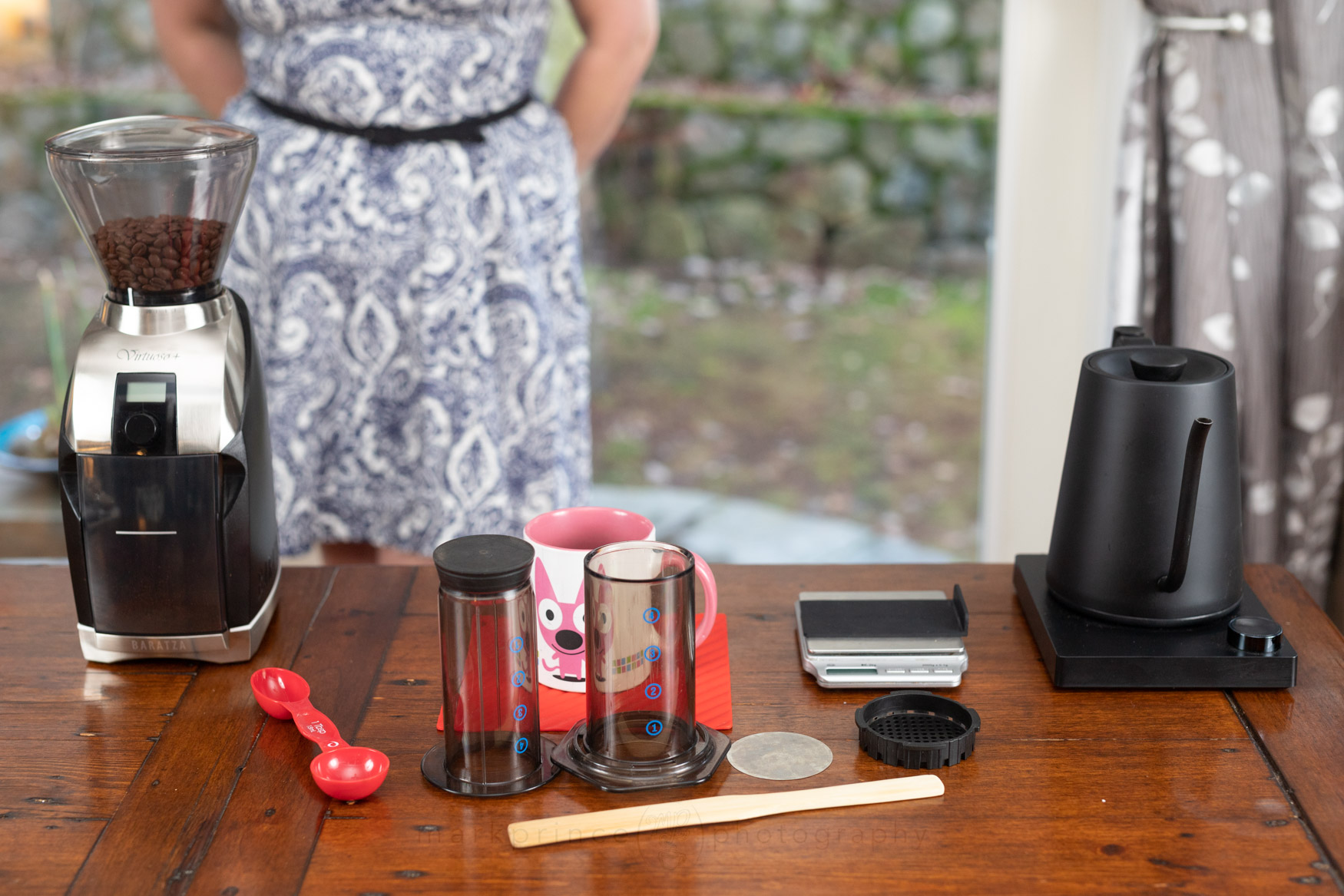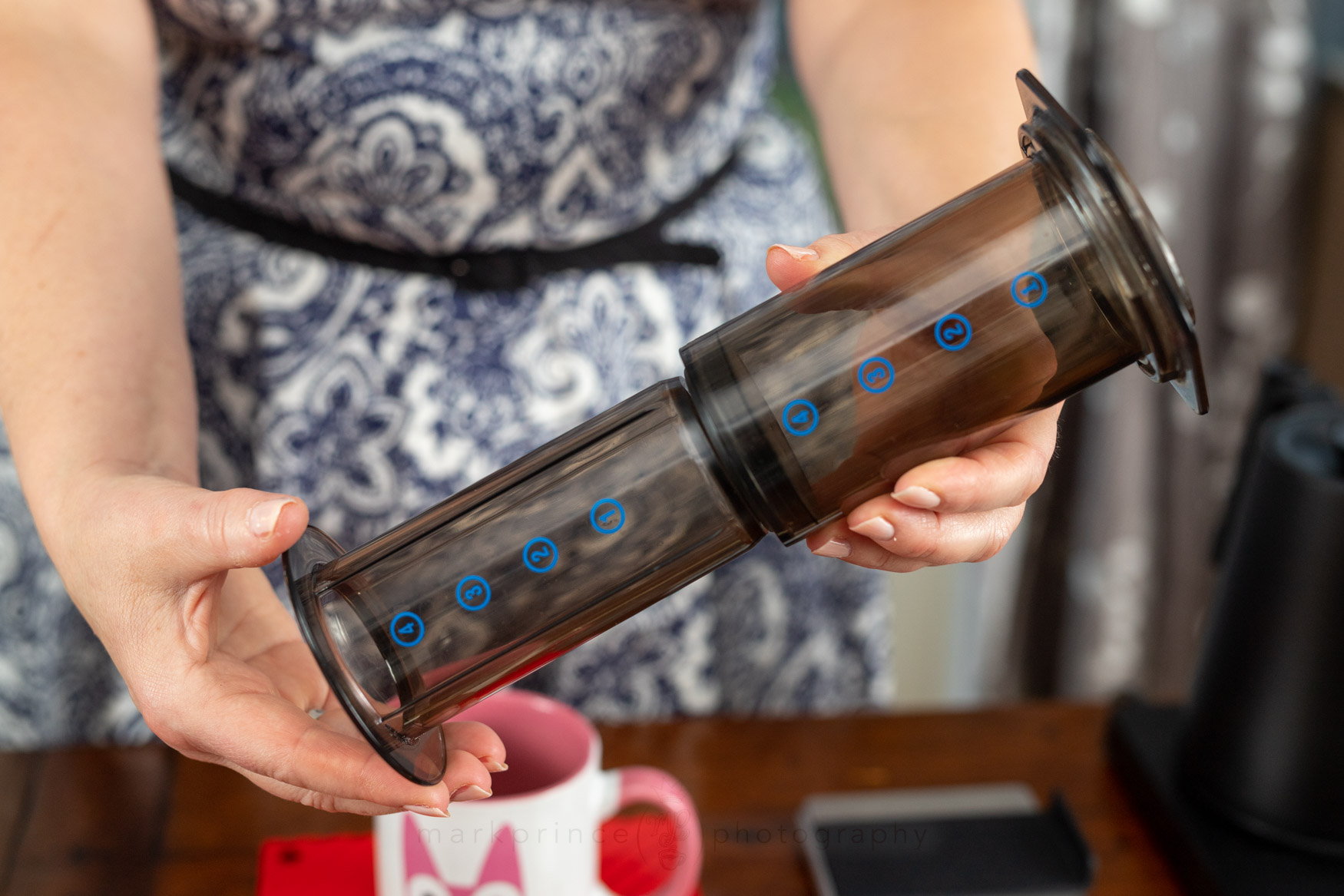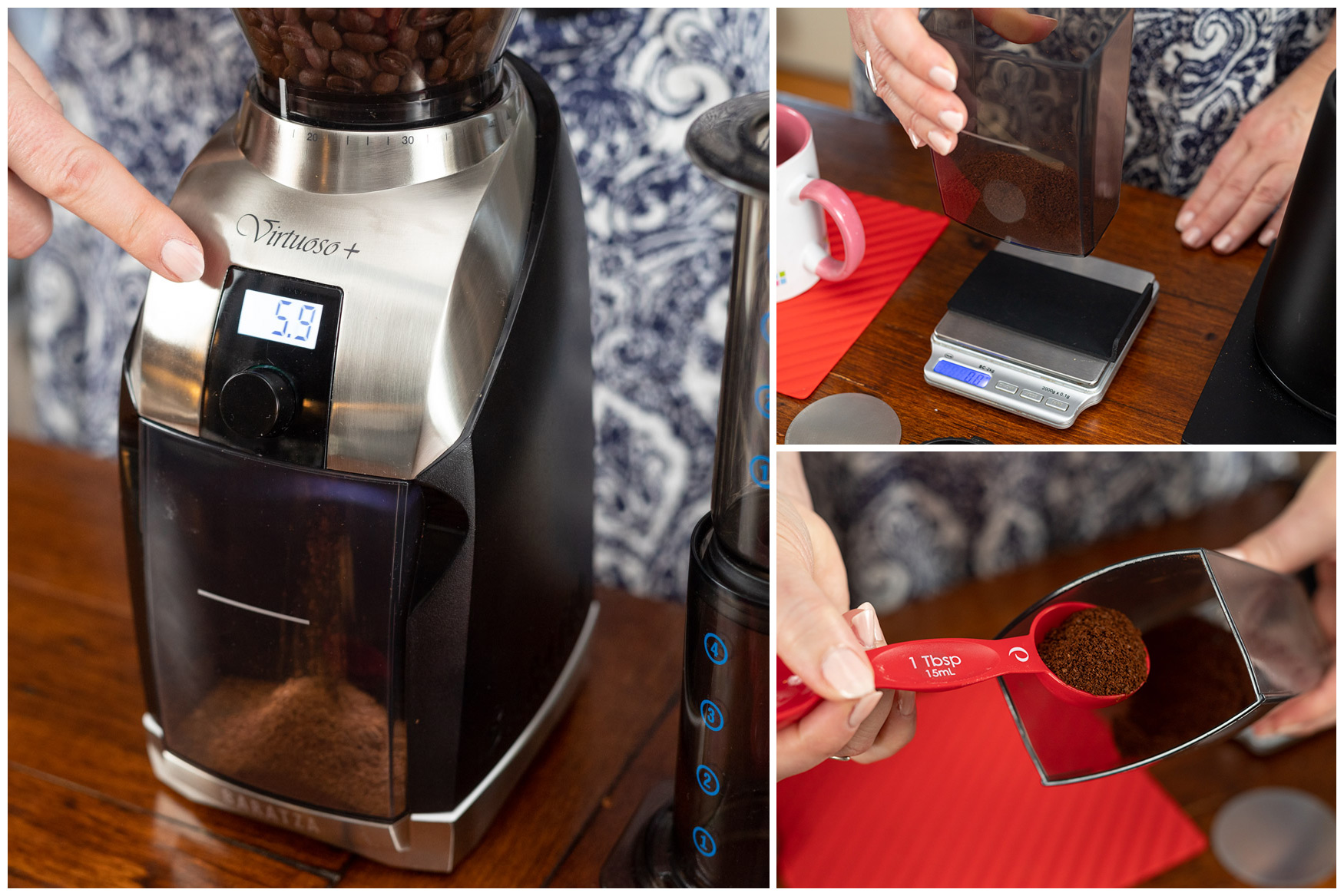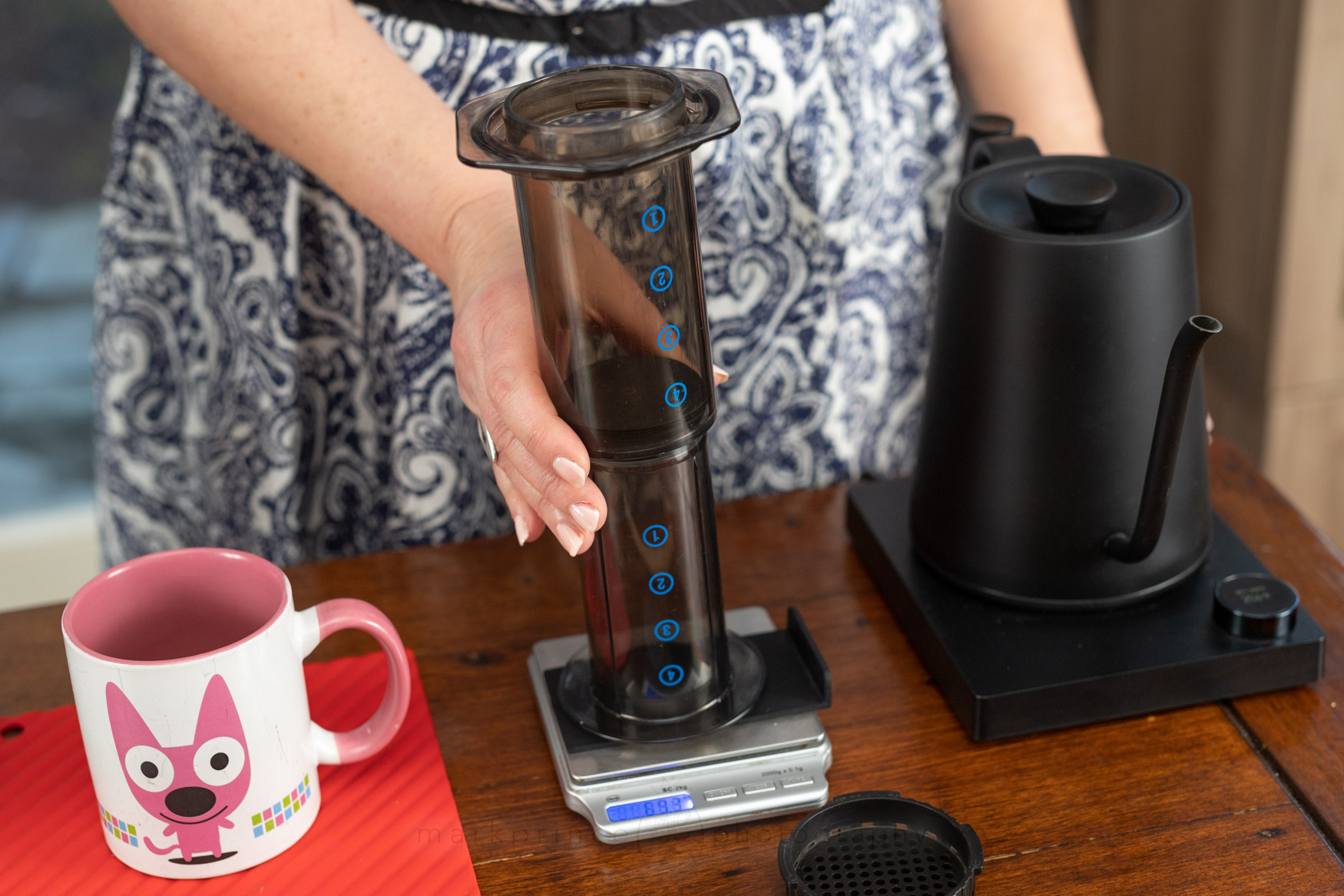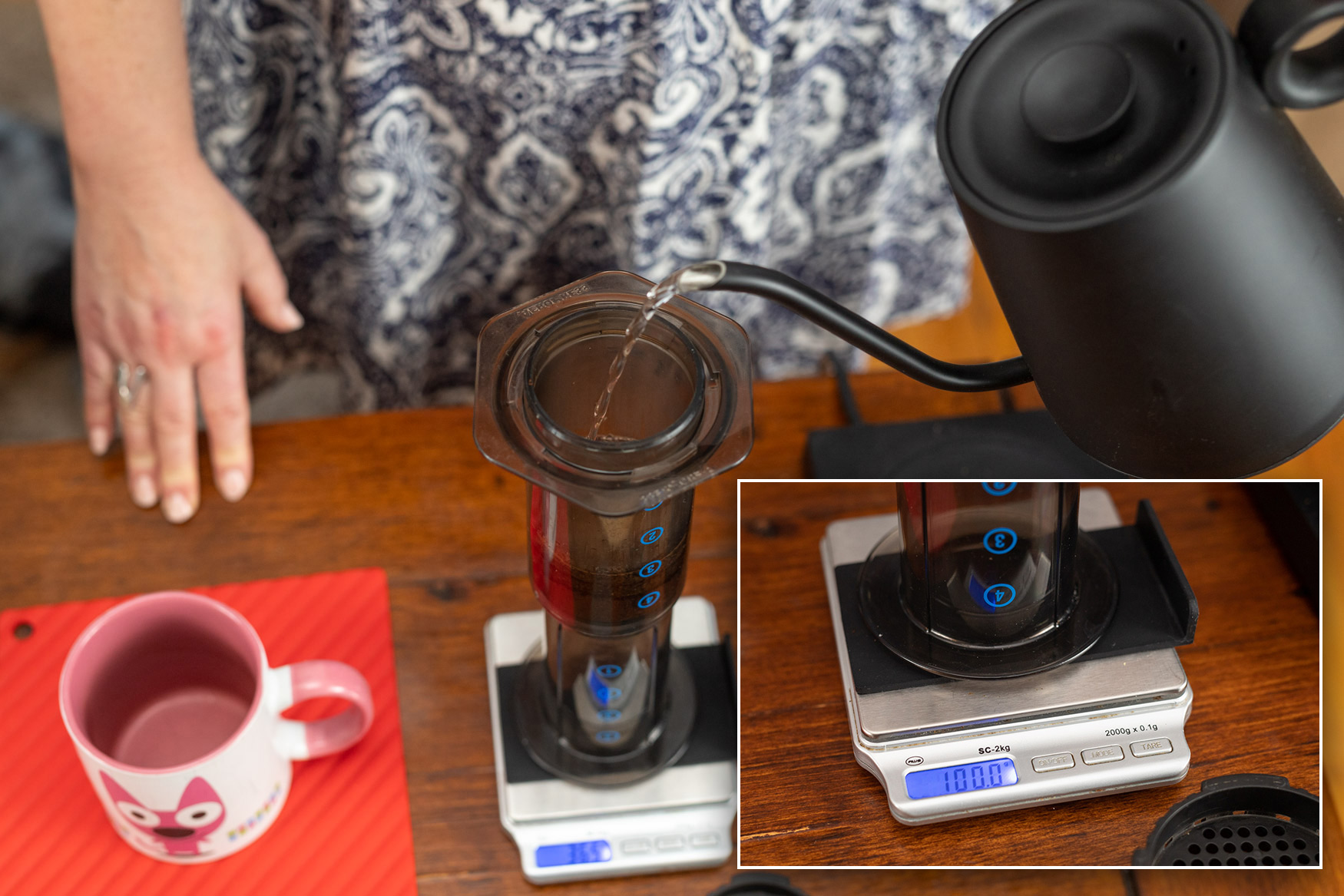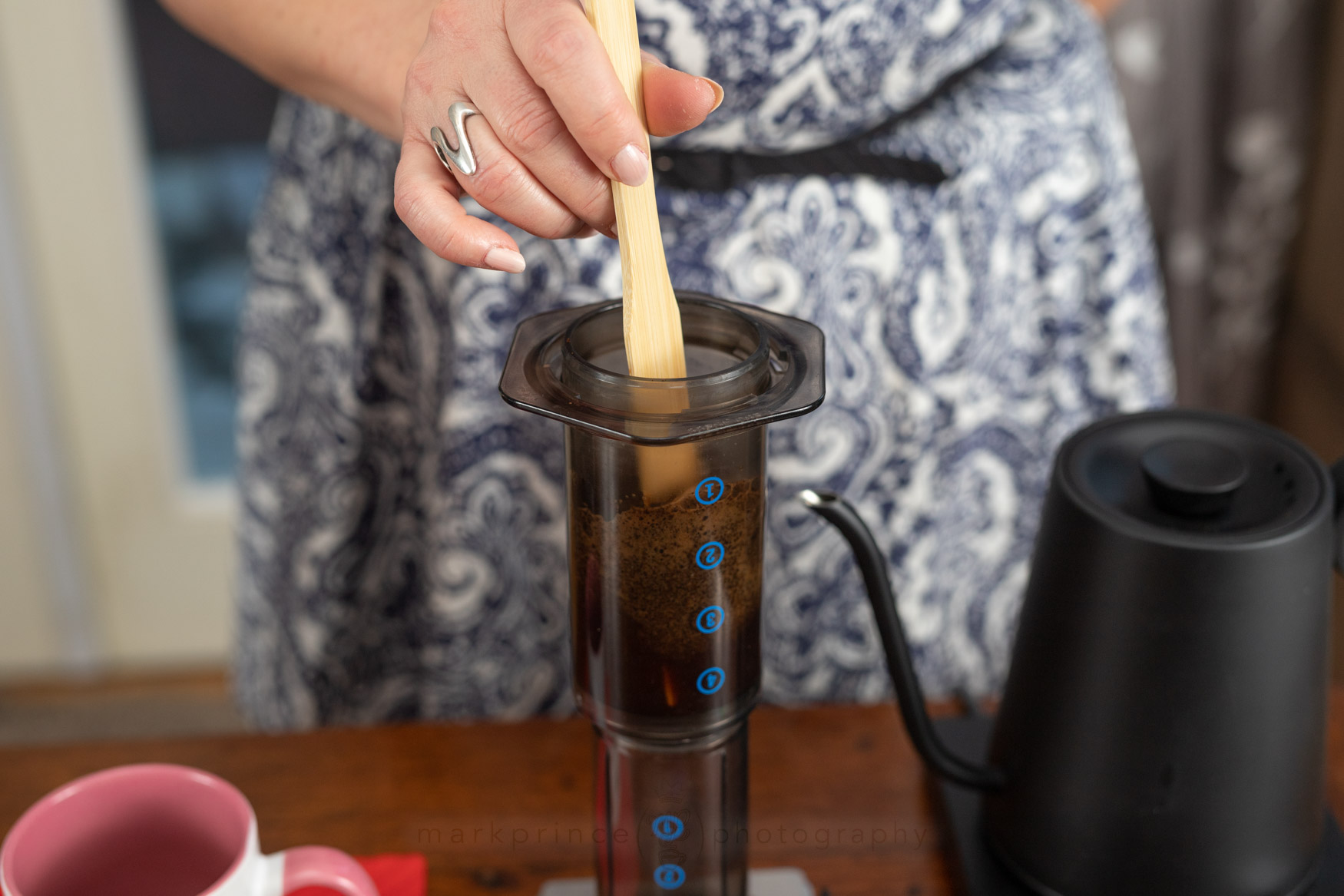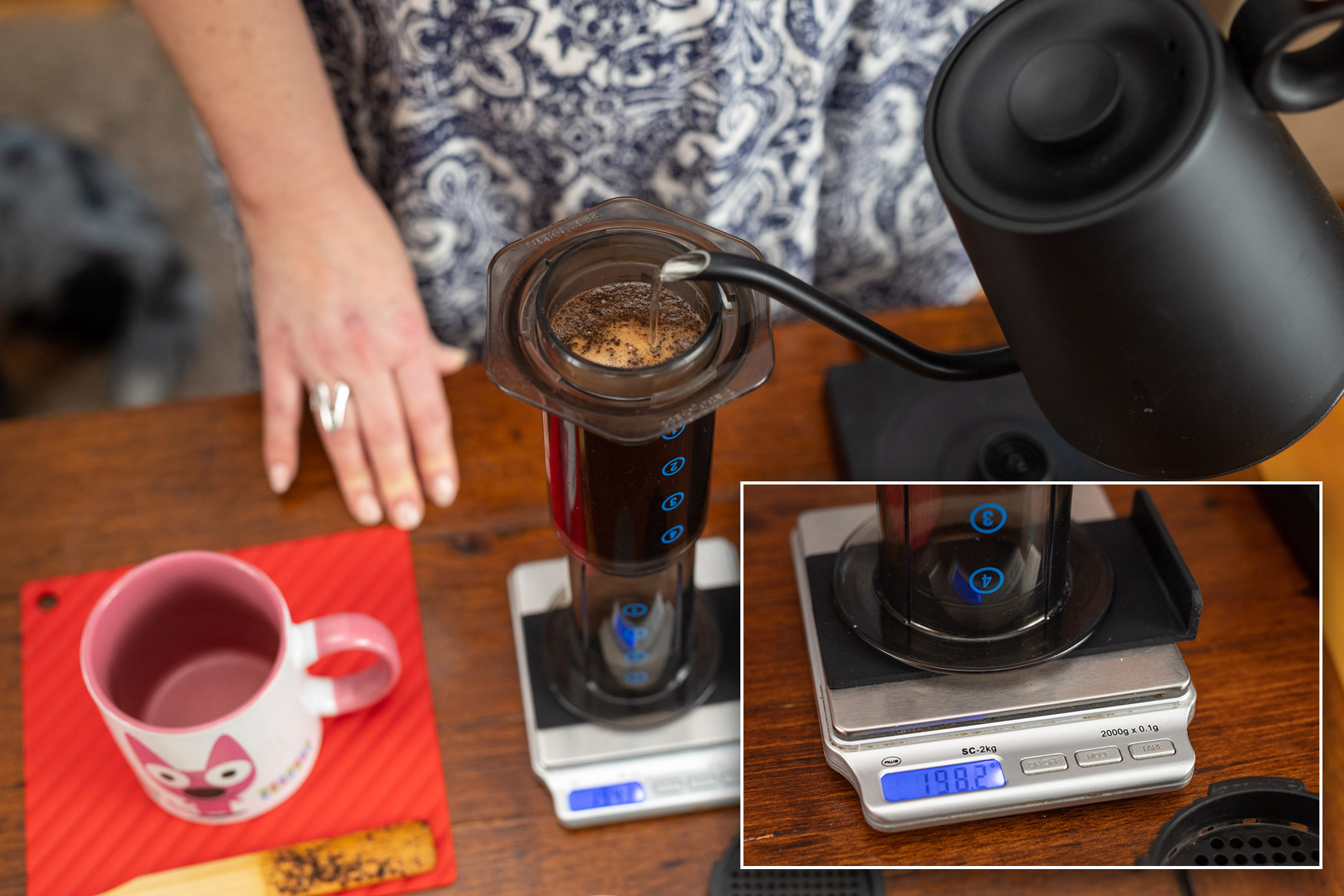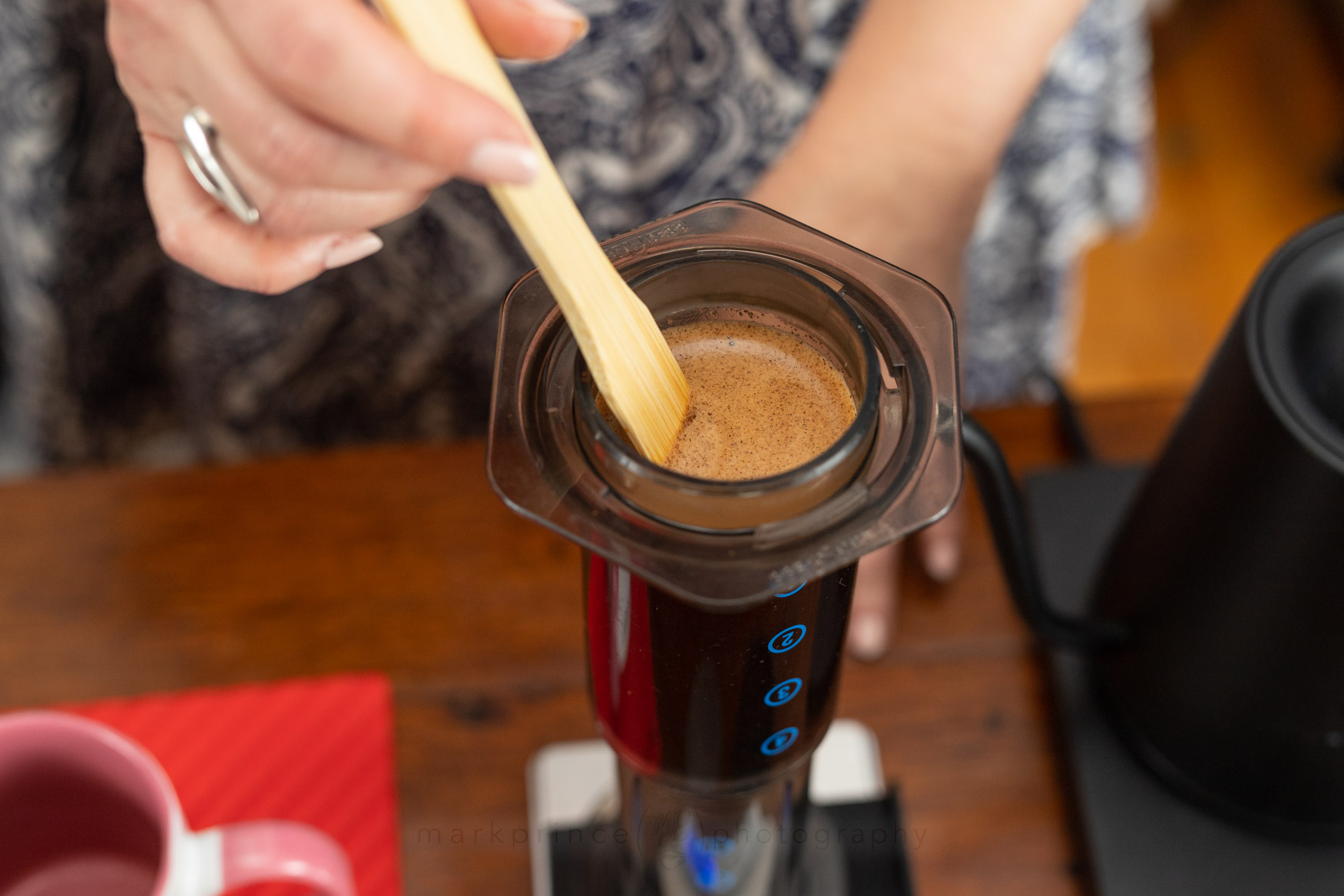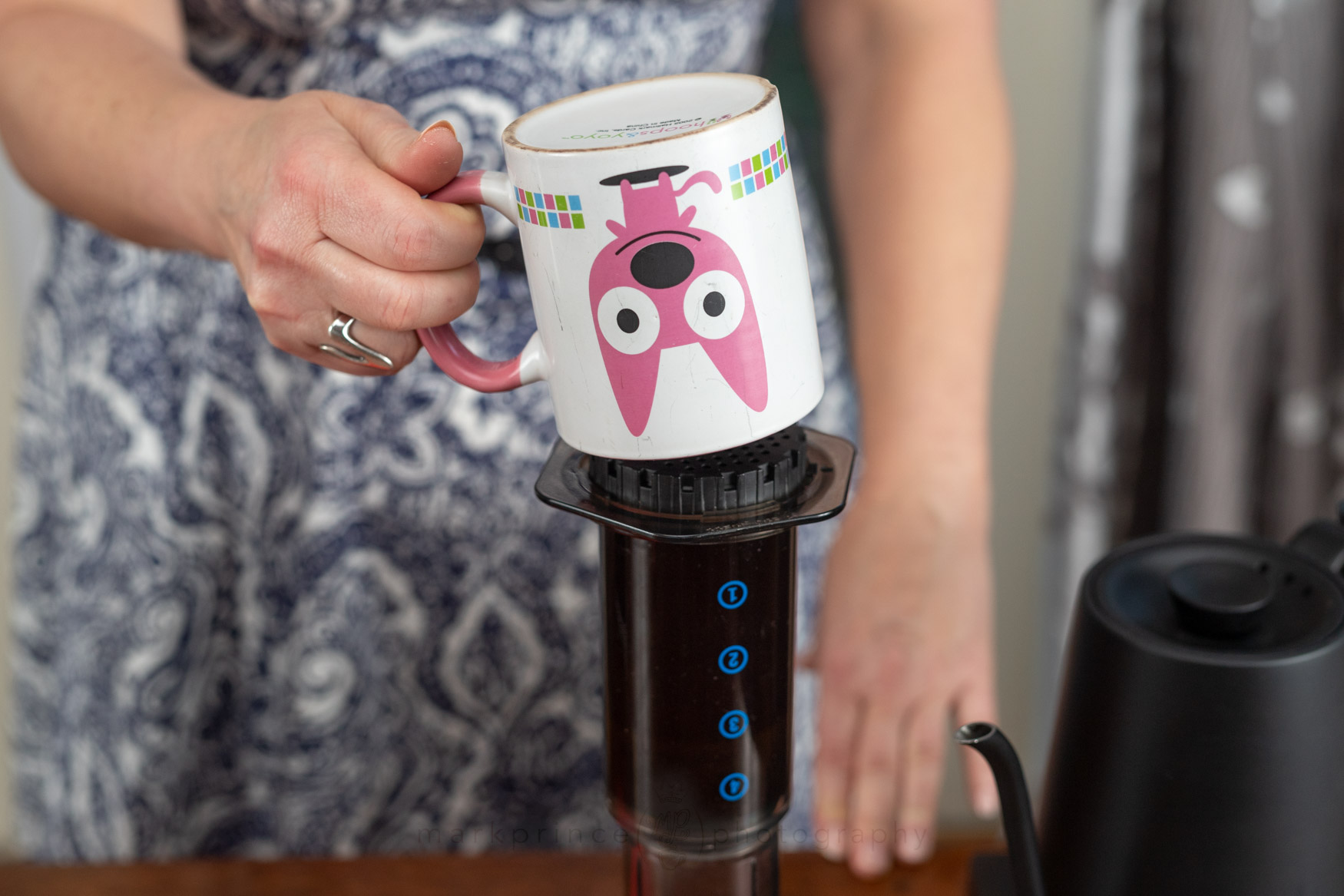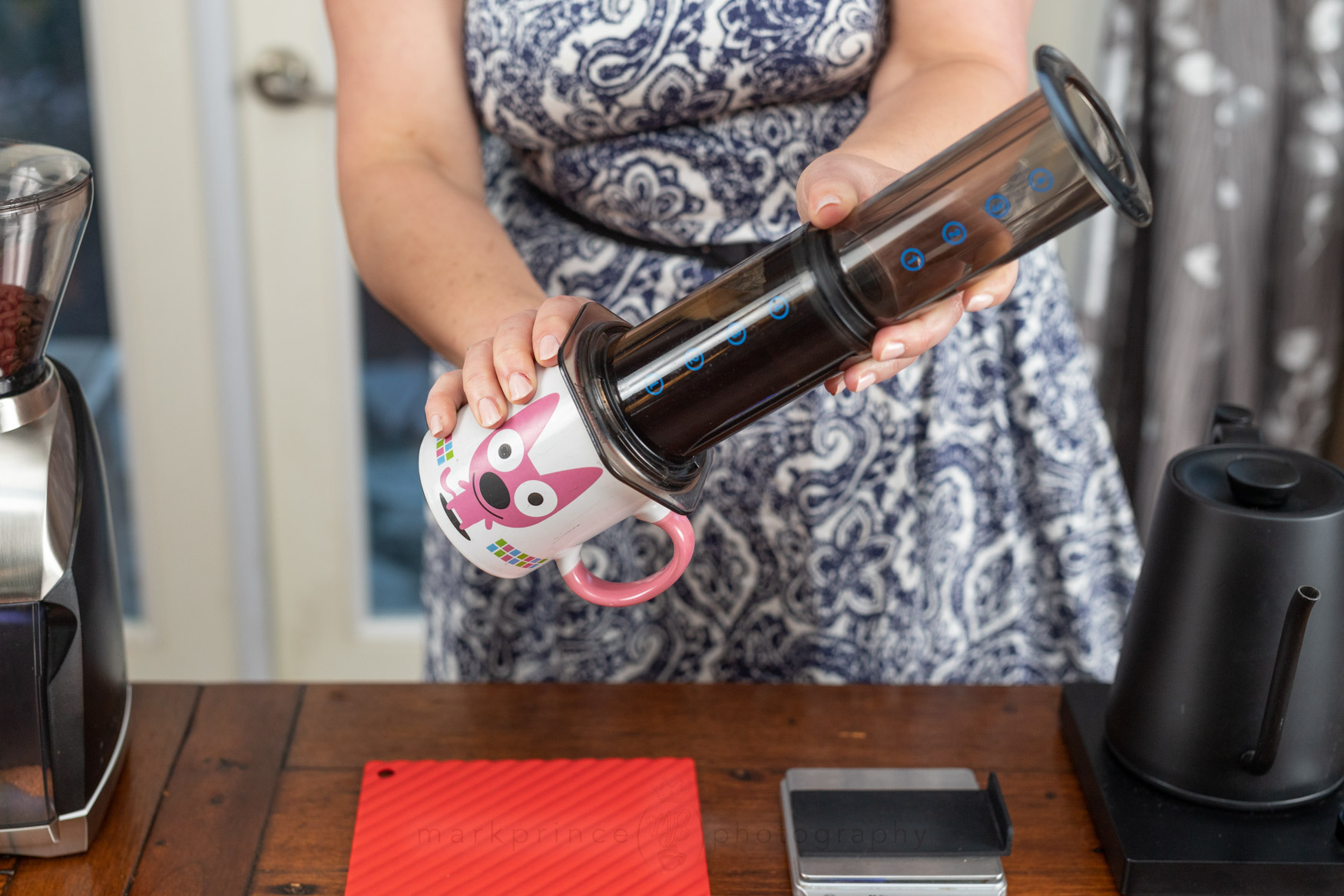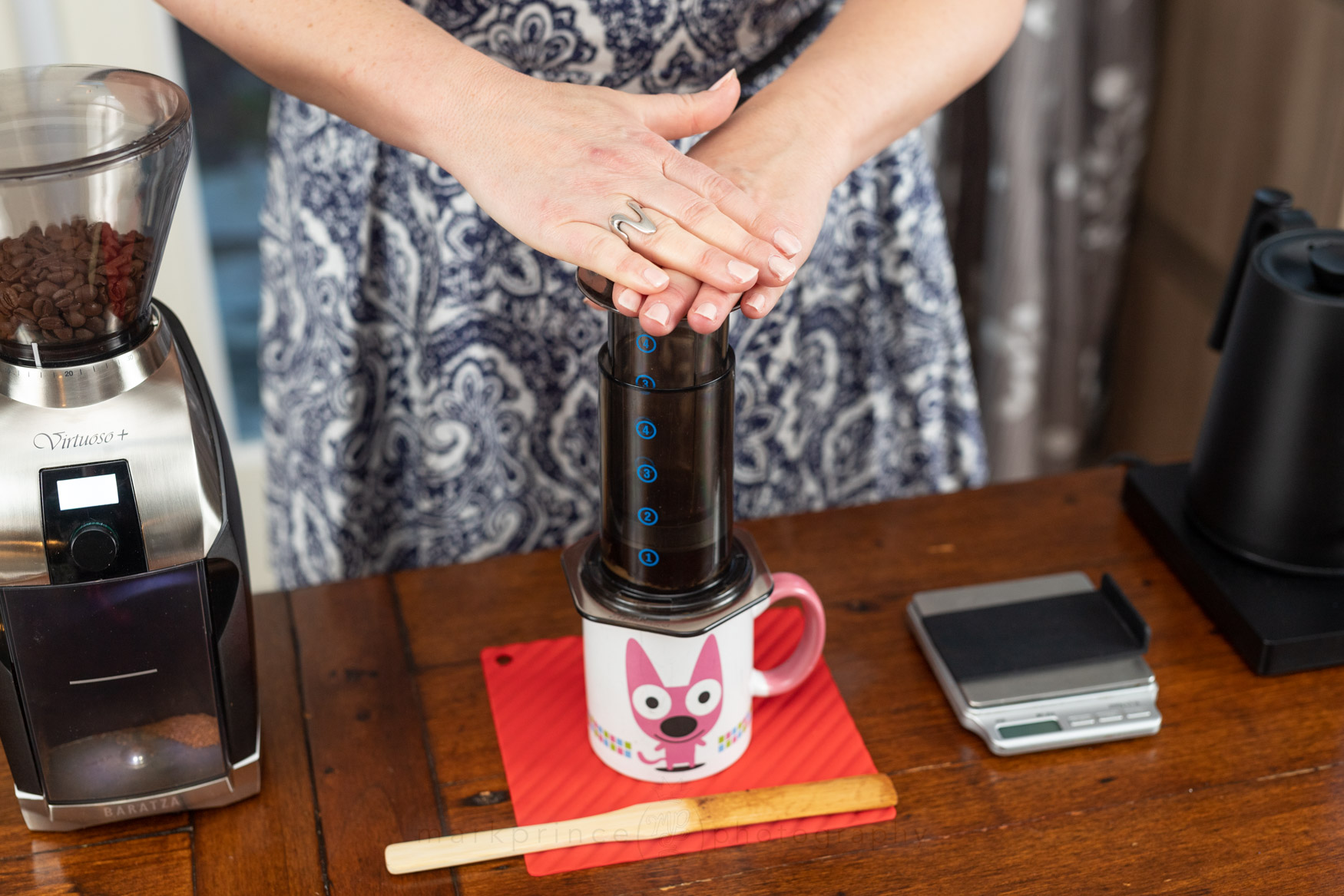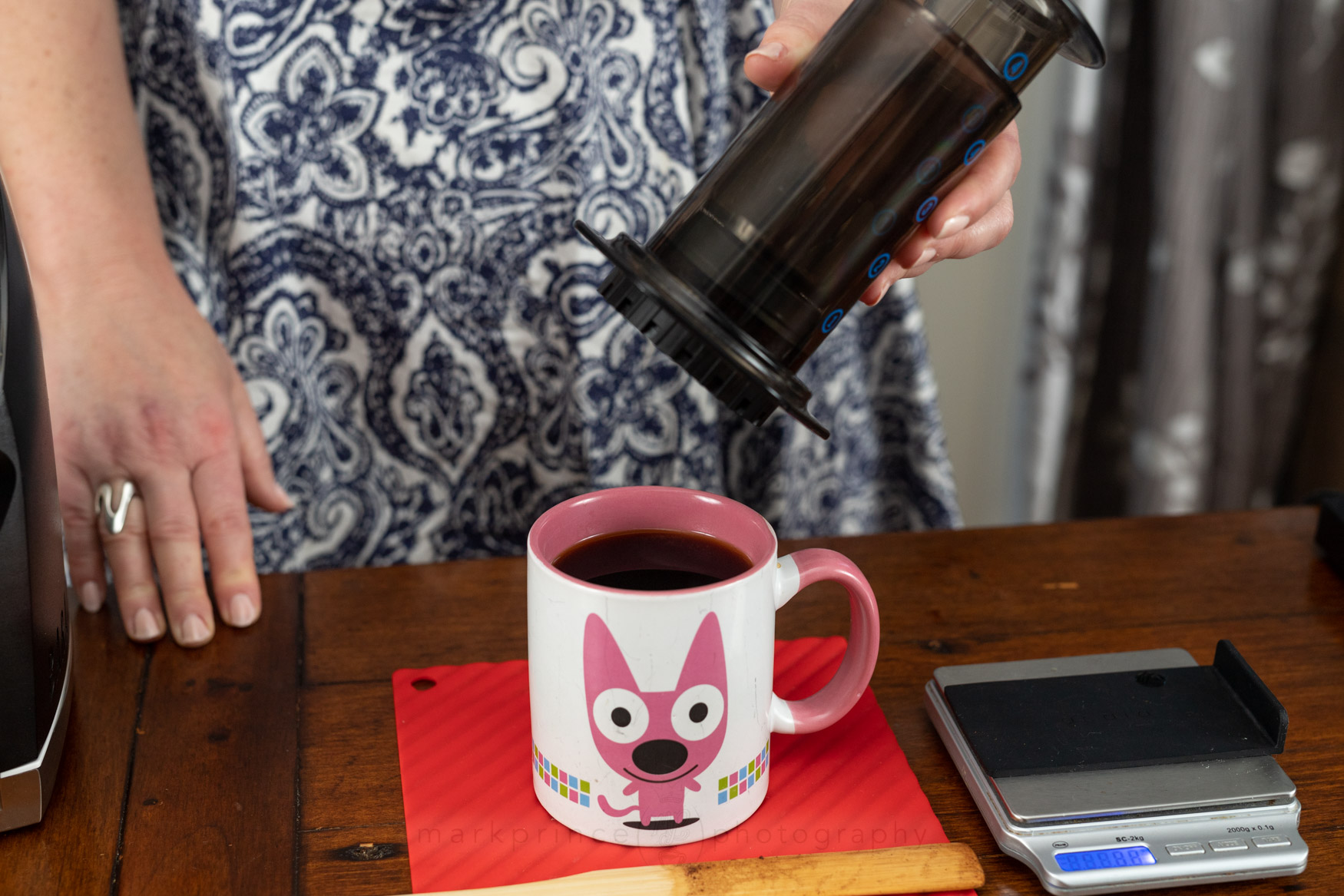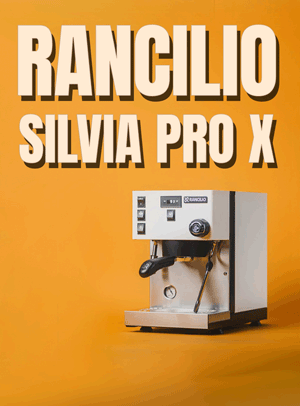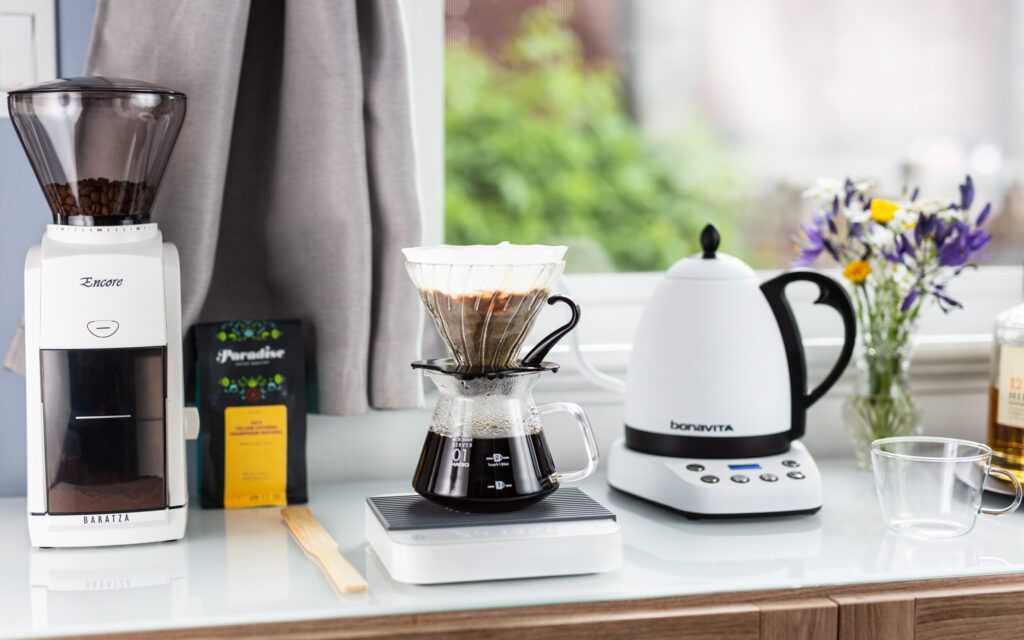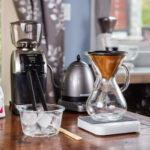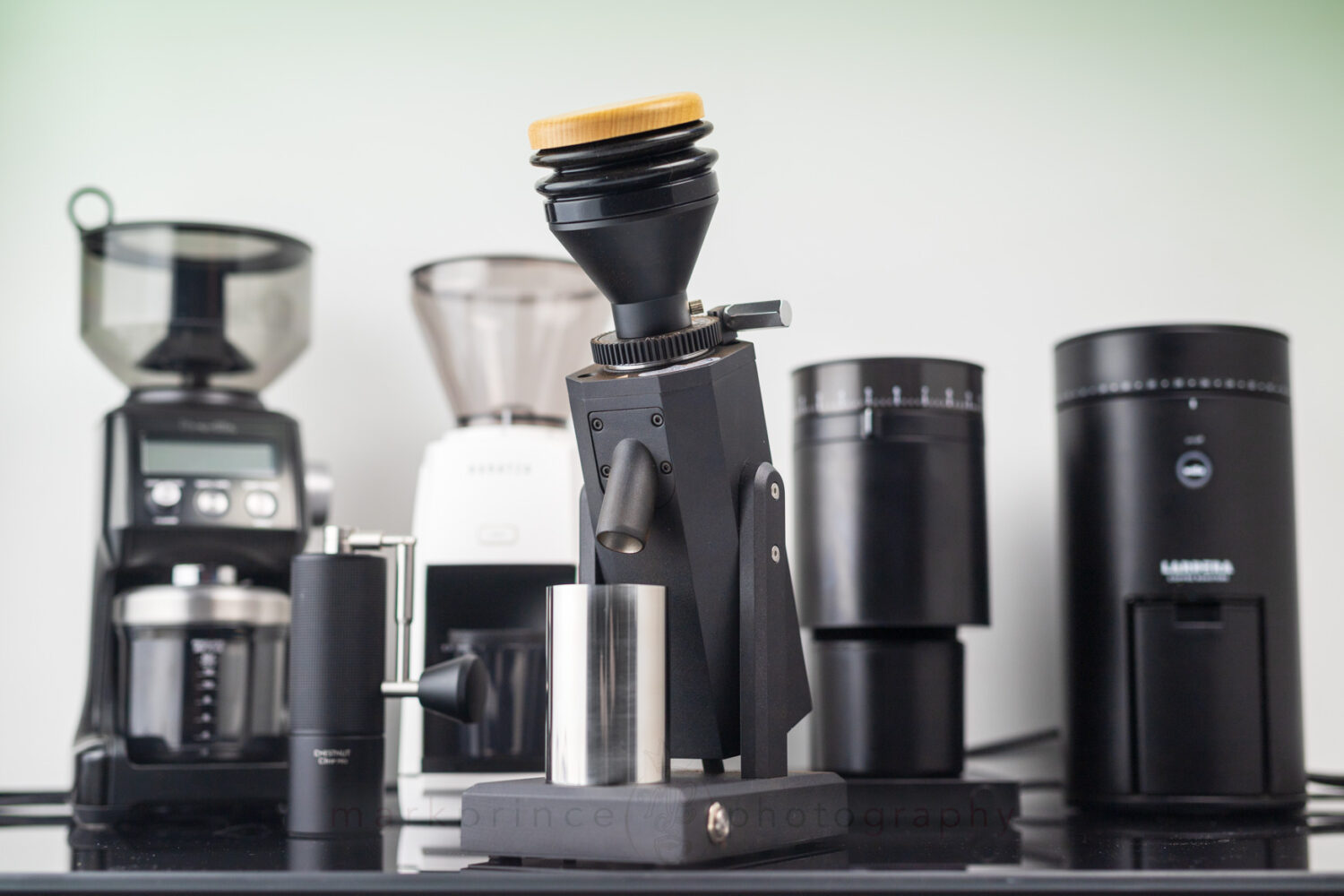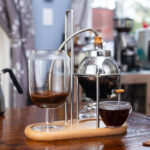How to Brew the Inverted Method with an AeroPress
Can you believe, cafes once paid over $10,000 to purchase a machine that brews coffee with a very similar method to this, producing very similar results in the cup. You can do it easily with a $35 brewer, a good grinder, and a normal water kettle and kitchen scale! This is a very fast brew process that takes about 90 seconds from first water pour to plunging out the coffee. Here we go.
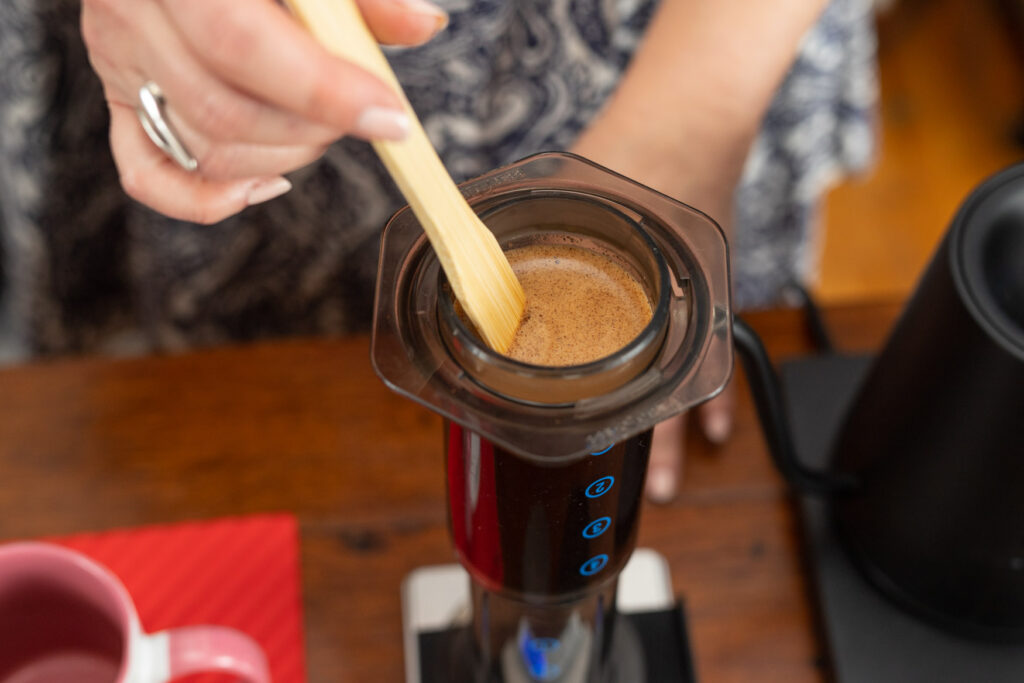
Time Needed: 2 minutes
Equipment Cost $ 175
Necessary Supplies
Necessary Tools
Inverted AeroPress Brew Steps
Arrange your Equipment
Arrange all your equipment and coffee together, as this is a fluid process and having everything at hand helps make a better cup. You’ll need the AeroPress brewer, a coffee grinder, a stirring stick of some sorts (it could be a wooden spoon handle, or a dedicated siphon stirring paddle made out of bamboo), an inexpensive kitchen scale (bonus if it reads down to .1g), a kettle, a mug, and your coffee.
Fire Up the Kettle
Fire up the kettle; if its temperature controlled, set it high, around 208-210F; if not, just let it get to boiling and turn off the heat.
Assemble AeroPress
Assemble the AeroPress. Take the plunger and insert it into the AeroPress piston just shy of 1cm into the piston, making sure it is perfectly lined up. If you have a scale, place the AeroPress on it, with the piston side down, or “upside down”.
Measure & Grind Coffee
Measure and grind the coffee. For this method, which is close to mimicking the output of a Clover brewer, we’re not going to grind as fine as some AeroPress brews (we’ll explain more below). The grind is a normal drip brew grind, around 750 microns. The dose is 21g which might seem a bit high, but again, we’ll get to the whys below. If you can’t measure by weight, 3 slightly rounded tablespoons is around 21g.
Place AeroPress on Scale
Place the AeroPress on the scale inverted, and zero (tare) the scale back to zero.
Add Ground Coffee
Add the coffee to the inverted, extended AeroPress, confirming 21g of coffee has been used. Once again, zero out the scale by hitting the tare button.
Pour in 100ml of Water
With your kettle fresh off the boil, or holding at 208F, pour about 100g of water into the inverted plunger.
Your extraction timer clock of 90 seconds starts as soon as you start pouring. Time: 10 seconds
Bloom, then Stir
Allow a slight bloom to form, but within 5 or 10 seconds of pouring, take your stir stick and give a few stirs to the slurry inside the inverted AeroPress, ensuring all the coffee has been mixed with the heated water. Time: 25 seconds
Pour Water to 200ml
Continue pouring hot water into the inverted AeroPress until you get to around 225g total water weight. Time: 40 seconds
Two More Stirs
Do two more stirs of the slurry, being careful not to overflow the top. Time: 50 seconds
Top Off Brew Chamber
Add another 40-50g of water if possible (super fresh coffees may bloom too much), filling the brew chamber to as close to the rim as you can. Time: 55 seconds
Attach Filter and Holder
Attach the metal filter and black filter holder to the top of inverted AeroPress, making sure it is screwed on tight. Be very careful at this point with hot water and accidentally knocking the plunger and piston apart. Time: 65 seconds
Flip Brewer and Mug
Very, very carefully, supporting both the mug and the brewer, holding it at the juncture where the plunger sits into the piston, flip everything over so the AeroPress is now sitting on the coffee mug. Time, 75 seconds.
Pause, Then Press on AeroPress Plunger
Wait 5-10 seconds, and begin plunging down on the AeroPress, to extract the brewed coffee. Use a smooth, continual movement; because of the ground fineness, it should press very smoothly, without excess resistance. Time 85 seconds
Inverted AeroPressDoses, Grind Levels, Brew Times
If you’ve read other AeroPress inverted guides, you’ll find most of them are quite different from this one. Most use smaller doses of coffee (as low as 15g for a 250ml brew), and most use the same identical AeroPress grind you’d use for a normal flow through brewing of the AeroPress.
The latter – the identical grind to a standard Aeropress brew – is where many are making a mistake. One of the reasons for going finer on the AeroPress is to restrict the flow through some what during the initial stages of the brewing process. If you brew inverted, you don’t have to worry about that.
The former is a much bigger point of contention: the dose used. We use 21g for the dose in our Inverted AeroPress method, with a coarser grind. This is for two reasons.
The first is, ours is a very fast brew time, which requires a larger dose to get the same kind of extraction you’d typically get from a 2 to 2.5 minute inverted brew with the AeroPress.
The second is because the coarser grind has less extraction ability (including a lesser chance of extracting excessive bitters) than the much finer grinds used for normal AeroPress brewing, so we’ve upped the dose to compensate.
Mimicking the Clover
There’s also a third reason. The Inverted Brewing method for the AeroPress came about partially as a way to clone the coffee output of a $10,000 on demand commercial coffee shop brewer, with a $30 plastic device. (you can read a lot more about that here). We’re talking about the Clover Coffee Maker.
In the Clover’s heyday, it was touted as a 90 second brewer on demand, and to do so, it used up to 2x the normal dose per 100ml brewed (12g) of coffee compared to other brewing methods. Yup, a 300ml cup from a Clover used 36g of coffee. And I know of some shops that used as much as 45g of coffee for that cup!
The thing is, the Clover presented a very new style of coffee. Some found it too weak, but many found it unveiled new and more delicate flavours in coffee.
Our Inverted Method for the Aeropress really does try to clone and replicate that brewing output. We don’t go to 2x dose levels that the Clover operators did, but through trial and error and a lot of tasting, we did come up with the 21g dose, the more “normal” pour over grind, and the very specific pours, stirs, pours, stirs and top off steps outlined above.
The timing is also crucial, but I do admit it’s also an attempt to say “yeah Clover, you claim 90 seconds? We got some 90 seconds too with this plastic toy here!” Though the reasons for the 90 second process were competitive in nature, it turned out to be a pretty good benchmark for delivering the type of cup that was pursued.
That said, this is another area you should feel absolutely free in playing around with as you develop your own AeroPress Inverted brewing technique.
Inverted AeroPressFilters, Temperatures, Taste
To get the absolute most out of this brewing method, a metal filter, like the Able Brewing DISK Fine, or AeroPress’ own metal filter, is a must. The Clover used a very complex metal filter system, and I believe paper blocks too many of the delicate flavours this brewing method can provide. Normally at this point I would be typing “… however, if you don’t have a metal filter, you can make do with paper…” but that’s not the case here.

Only Metal Filters for this Method
On Temperatures
A crazy amount of thought, practice, and trial and error went into this, with this specific brewing method, and we’ve found over the years that just off boil works great for the Inverted AeroPress Method. But why is that?
When Alan Adler invented the AeroPress, he recommended 175F as the brewing temperature. We did find out early on he was using extremely dark roast coffees, and if you’re a CoffeeGeek worth your espresso machine, you know the darker the roast, the cooler the brewing temperatures. Still, 175F is pretty low.
In researching this updated guide, I’ve read about a dozen Inverted AeroPress guides online, and it seems one person, somewhere, said 90C water temperatures (194F), and many of the other guides just went with that number. But it’s a bad number, at least for our method and the brewing device.
First, the most optimal temperature for coffee extraction, according to the Specialty Coffee Association, is around 200F. Higher for lighter roasts, lower for darker roasts, so a range around 196F to 204F. Second, when you add hot water to an inverted AeroPress, a lot of that initial water temperature energy is eaten up by the room temperature grinds, the insulating plastic, and the exposed open top. Third, it’s small volumes of water – less than 250ml total – added in stages.
Based on these three things, we’ve settled on a starting temperature of at least 208F in a temperature controlled kettle, or “just off boil” with a normal kettle. I’ve run very expensive Fluke thermoprobes in the slurry to verify this, but even just off the boil, the water temperature inside the coffee slurry never gets higher than 201F, and that’s usually by the time 200ml is inside the AeroPress.
By contrast, we’ve tried tests starting with 200F water in a kettle, and noted the brewing temperatures inside the AeroPress are around 185F-190F at peak. Given the very fast brewing times, this isn’t good enough. You want absolutely optimal – in the brewing chamber – for almost all the brew.
So definitely start with hotter water – even water just off the boil – if you want to get to that Clover cup experience. Speaking of which.
The Cup Taste
The goal of this specific Inverted AeroPress method is to produce the absolute best cup qualities the Clover did during its heyday: a lighter coffee showcasing more delicate and fleeting flavours no other brewing method could provide.
This is why we use 21g of coffee, hotter starting water, and very precise pours, stirs, pours, more stirs, and top offs. It’s also why the 90 second timeline works.
One thing I discovered through this 15 year ongoing process is, this method – much like the Clover – left behind bitters that most other brewing methods and devices would extract. It did this at the sacrifice of some body, additional texture and so-called “balance”, providing a lighter cup of coffee. But the aromas are enticing, and the nuance of the cup can be absolutely spectacular. You might very well taste things from a coffee bean that you won’t taste using any other brewing method.
Other Inverted AeroPress brewing methods seek out TDS levels comparable to V60 brews or ideal 1.17 ratios. But we’re not trying to get maximum extraction or mimic the V60 with this brewing method.
We’re trying to brew something unique and memorable. Give it a try yourself!

Support CoffeeGeek
If you enjoy and learn from this resource, please consider making a one time or recurring donation to help support our work and fund purchases for future reviews.


















